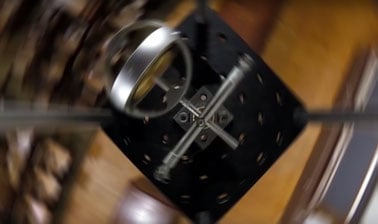The online pendulum simulations on this page show us in a practical way how a pendulum works. We will discover the main types of pendulums, their parts, their movement, and the forces and energy that act on a pendulum.
What is a pendulum
A pendulum is a system consisting of an object suspended from a fixed point that swings back and forth under the action of gravity. Its movement is a classic example of simple harmonic motion when the oscillations are small. There are several types, such as the simple pendulum and the physical pendulum, each with its own characteristics and formulas for calculating the period.
Types of pendulums
There are different types of pendulums depending on their construction and application. The most common are the simple pendulum, the physical pendulum, and the torsion pendulum.
Simple pendulum
It consists of a point mass (called a bob) suspended from a light string or rod. It is the most commonly used model for studying simple harmonic motion in physics.
Physical pendulum
It consists of a rigid body that oscillates around a suspension point. It is used to calculate moments of inertia and study systems that are more complex than the simple pendulum.
Torsion pendulum
Instead of oscillating due to gravity, it rotates around its axis due to the torsion of a wire. It is commonly used in precision clocks and laboratory experiments.
Parts of a pendulum
A pendulum, regardless of its type, is composed of several key elements that determine its operation:
Mass (bob)
This is the weight that hangs from the pendulum. Its shape and density can influence air resistance, but do not affect the period if the movement is ideal.
String or rod
This is the element that holds the mass and defines the length of the pendulum. It can be flexible (string) or rigid (metal or wooden rod).
Suspension point
This is where the string or rod is attached. It acts as a pivot point and determines the stability of the movement.
Movement of a pendulum. Force, energy, and period
A pendulum moves thanks to the force of gravity, which acts as a restoring force. When the mass is displaced from its equilibrium position and released, gravity pulls it downwards, converting potential energy into kinetic energy in a repeating cycle. At the highest point, the pendulum has maximum potential energy and zero velocity; as it passes through the lowest point, it has maximum kinetic energy and maximum velocity; the movement continues to alternate between these two forms of energy.
Forces in a pendulum
In a pendulum, the movement is governed mainly by two forces:
Gravity, which always acts towards the center of the Earth and is responsible for returning the pendulum to its equilibrium position.
The tension in the string or rod, which keeps the mass in its circular path and compensates for part of the weight.
In each oscillation, these forces interact to accelerate or slow down the mass depending on its position.
Energy in the pendulum
In an ideal pendulum (without friction), total mechanical energy is conserved, transforming between:
Gravitational potential energy, which is maximum when the mass is at its highest point.
Kinetic energy, which is greatest at the equilibrium position, where the velocity is highest.
In the real world, air resistance and internal friction dissipate some of this energy, reducing the amplitude over time.
Period of a pendulum
The period is the time it takes for the pendulum to complete one full swing. For a simple pendulum, with small swings and under ideal conditions (no friction or air resistance), the period T is calculated using the following formula:
T = 2π √(L/g)
Where:
L is the length of the string or rod
g is the acceleration due to gravity
Applications of pendulums
Pendulums are used in timekeeping, such as in pendulum clocks, and in physics experiments to determine gravity or study simple harmonic motion. They also appear in modern applications, such as sensors and navigation devices, and have captured the popular imagination as symbols of precision and stability. Throughout history, their study has led to important advances in mechanics and experimental physics.
Explore the exciting STEM world with our free, online simulations and accompanying companion courses! With them you'll be able to experience and learn hands-on. Take this opportunity to immerse yourself in virtual experiences while advancing your education - awaken your scientific curiosity and discover all that the STEM world has to offer!
Pendulum simulations
- Forces
- Energy
- Period
- Lab I
- Lab II
Forces in a pendulum
This simulation allows us to observe the forces acting on a pendulum.
Energy in a pendulum
The energy in a pendulum swings between potential and kinetic. Where has the energy of this pendulum gone?
Period of a pendulum
In this simulation you can modify the length of a pendulum and the maximum angle of oscillation. Find out how to calculate the period of a simple pendulum and of a physical pendulum and explain how each of these parameters affects the period.
Pendulum Laboratory
Play with one or two pendulums and discover how the period of a simple pendulum depends on the length of the chain, the mass of the pendulum, the force of gravity, and the amplitude of the oscillation. Observe the energy in the system in real time and change the amount of friction. Measure the period using the timer or stopwatch. Use the pendulum to find the value of g on Planet X. Observe the anharmonic behavior at large amplitude.
File
- Forces I
- Energy I
Forces in a pendulum
In this simulation you can see the force diagram of a pendulum as it is pulled or pushed back and forth. Observe how equilibrium is reached between the three forces acting on the ball. In which position is the tension the least?
Giants of science
“If I have seen further, it is by standing on the shoulders of giants”
Isaac Newton

René Descartes
–

Galileo Galilei
–
Become a giant


Mechanics, Part 2



Mechanics, Part 1



Dynamics and Control



Circuits for Beginners



AP® Physics 1 – Part 4: Exam Prep



AP® Physics 1: Challenging Concepts



The Basics of Transport Phenomena
































